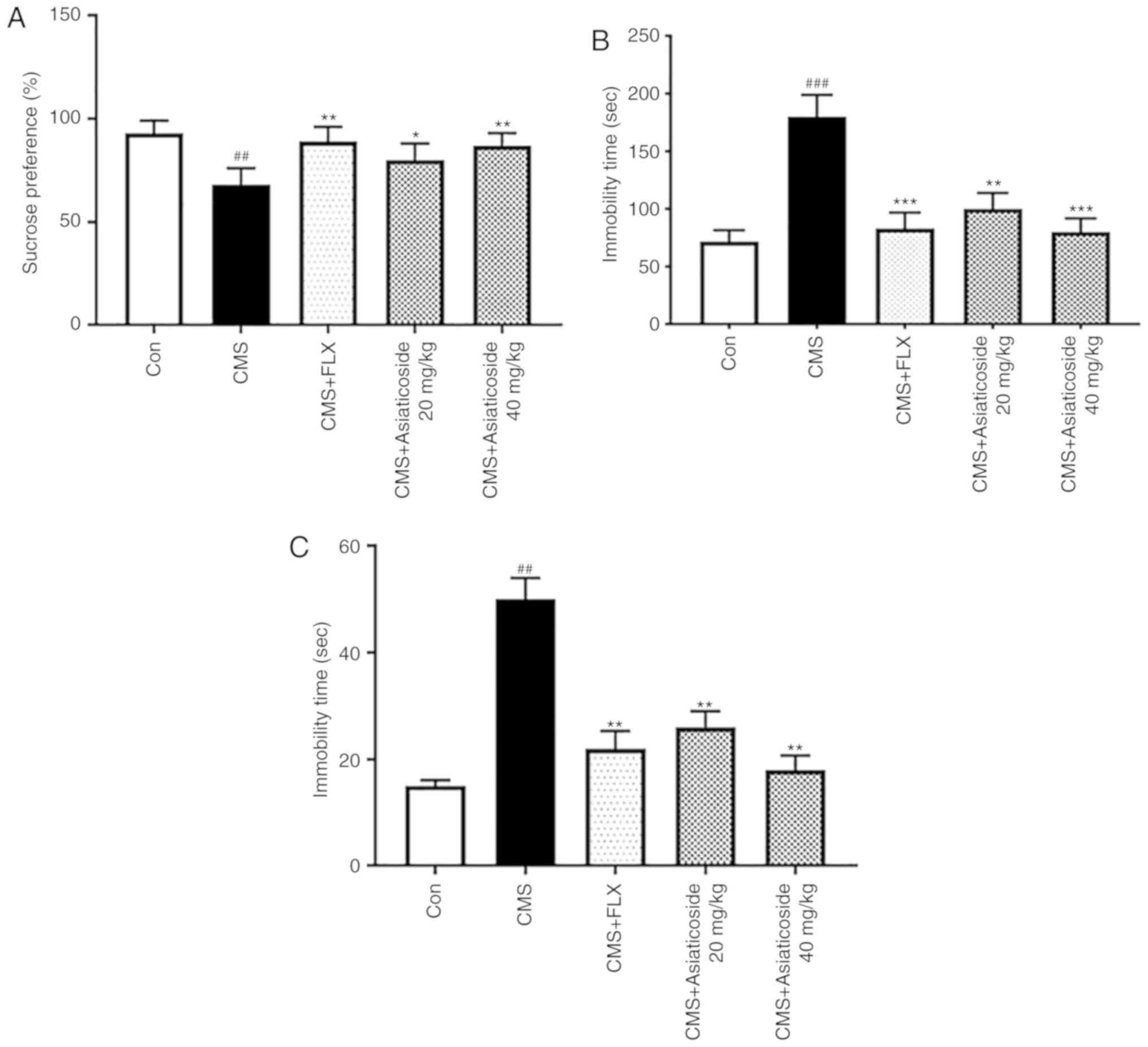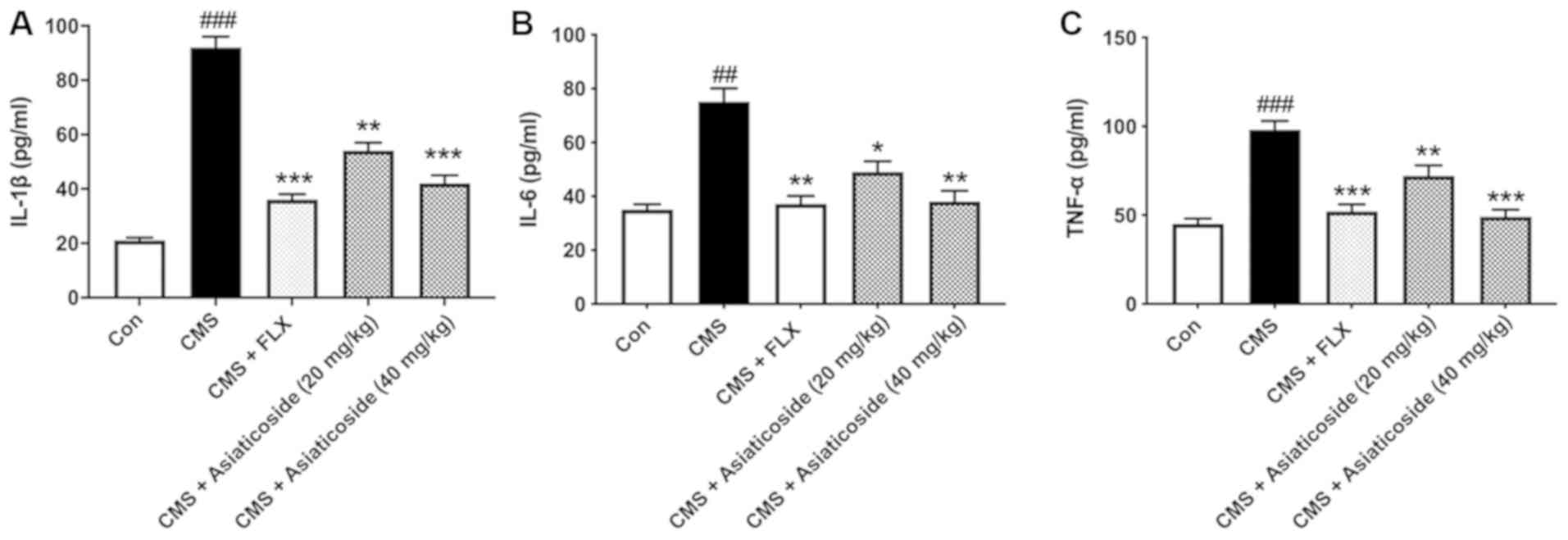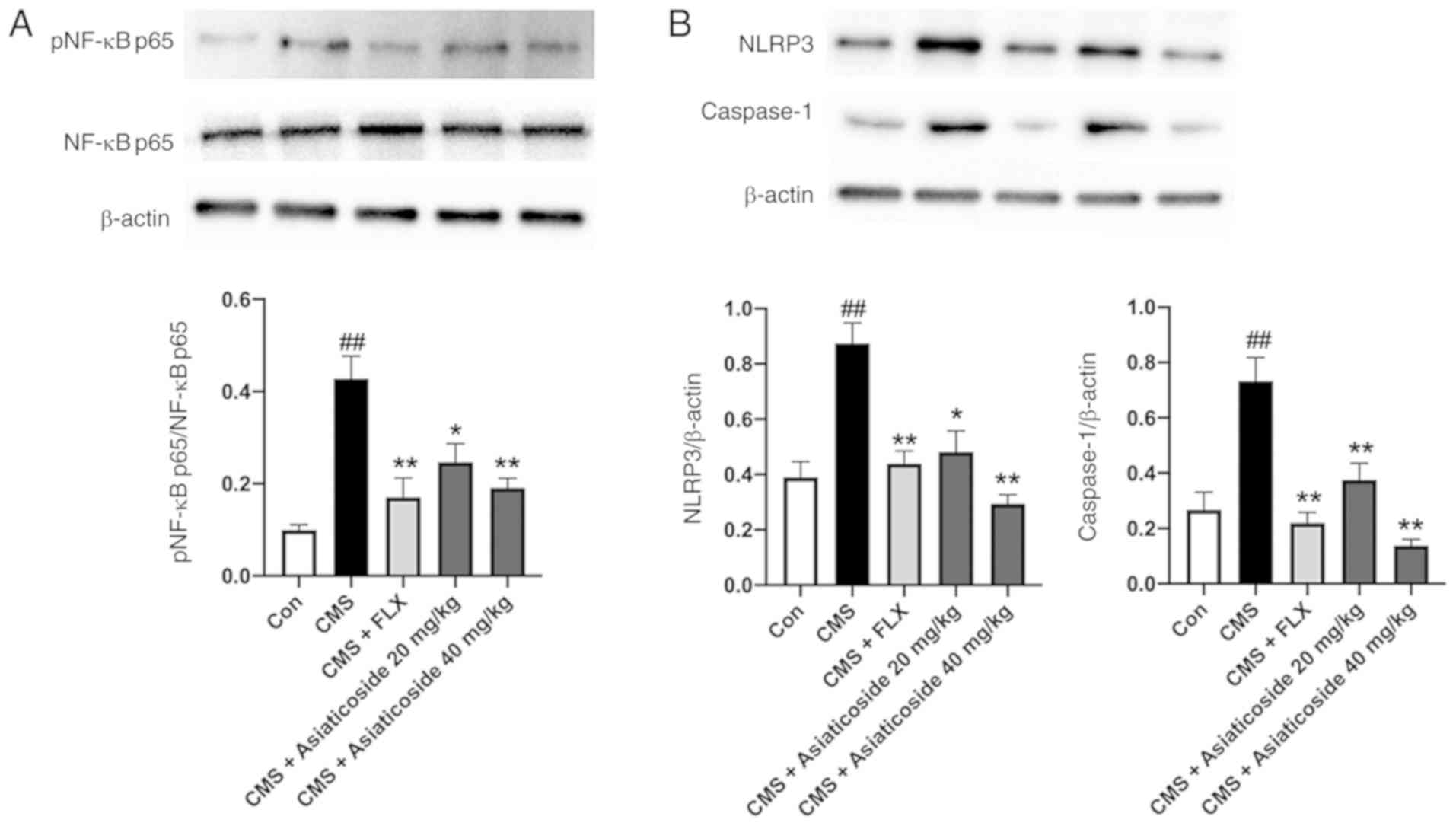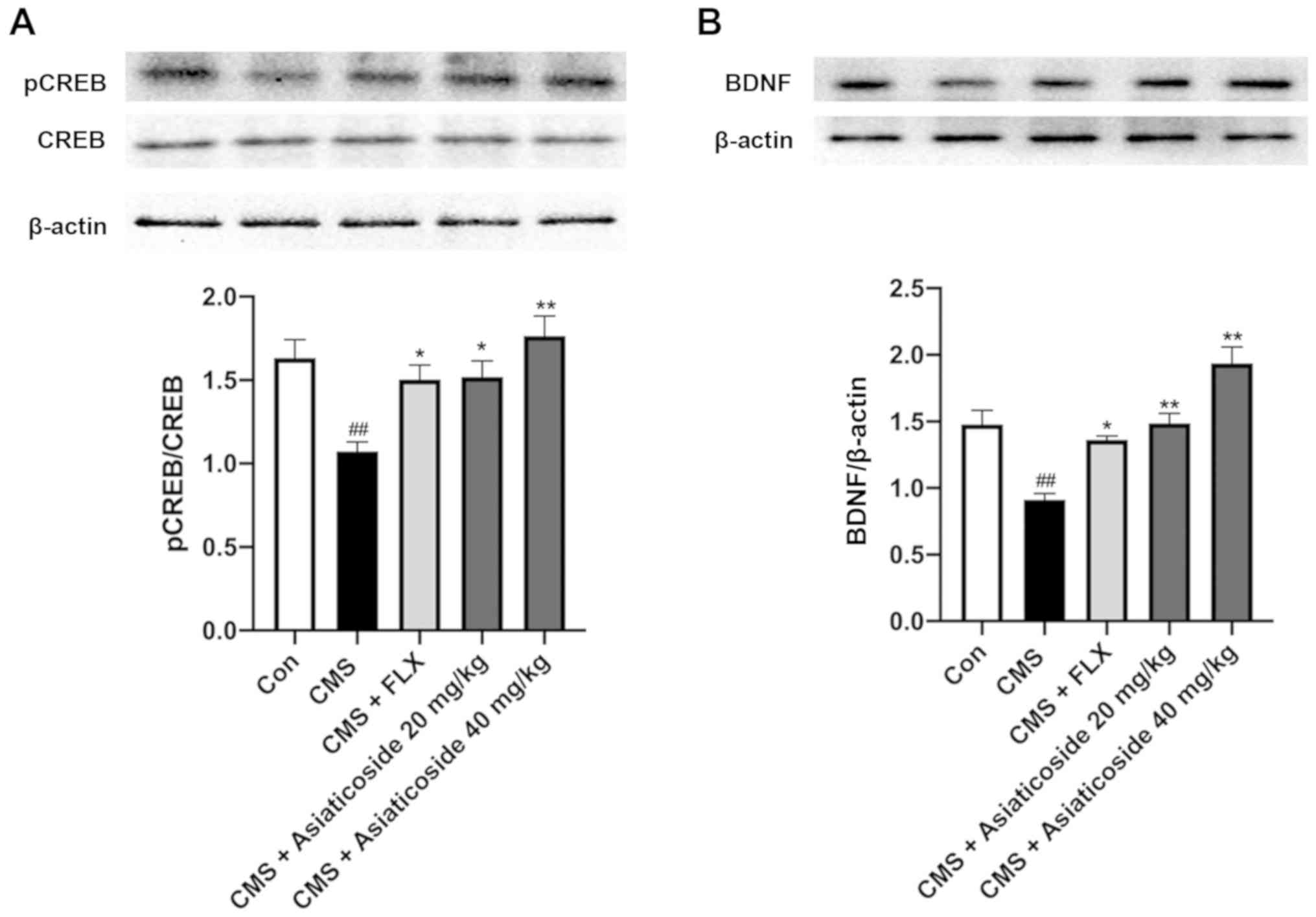|
1
|
Ota KT and Duman RS: Environmental and
pharmacological modulations of cellular plasticity: Role in the
pathophysiology and treatment of depression. Neurobiol Dis.
57:28–37. 2013. View Article : Google Scholar : PubMed/NCBI
|
|
2
|
Yu HY, Yin ZJ, Yang SJ, Ma SP and Qu R:
Baicalin reverses depressive-like behaviours and regulates
apoptotic signalling induced by olfactory bulbectomy. Phytother
Res. 30:469–475. 2016. View
Article : Google Scholar : PubMed/NCBI
|
|
3
|
Lee WY, Jang SW, Lee JS, Kim YH, Kim HG,
Han JM, Kim DW, Yi MH, Choi MK and Son CG: Uwhangchungsimwon, a
traditional herbal medicine, protects brain against oxidative
injury via modulation of hypothalamus-pituitary-adrenal (HPA)
response in a chronic restraint mice model. J Ethnopharmacol.
151:461–469. 2014. View Article : Google Scholar : PubMed/NCBI
|
|
4
|
Miller AH and Raison CL: The role of
inflammation in depression: From evolutionary imperative to modern
treatment target. Nat Rev Immunol. 16:22–34. 2016. View Article : Google Scholar : PubMed/NCBI
|
|
5
|
Inserra A, Mastronardi CA, Rogers G,
Licinio J and Wong ML: Neuroimmunomodulation in major depressive
disorder: focus on caspase 1, inducible nitric oxide synthase, and
interferon-gamma. Mol Neurobiol. 56:4288–4305. 2019. View Article : Google Scholar : PubMed/NCBI
|
|
6
|
Liberman AC, Trias E, da Silva Chagas L,
Trindade P, Dos Santos Pereira M, Refojo D, Hedin-Pereira C and
Serfaty CA: Neuroimmune and inflammatory signals in complex
disorders of the central nervous system. Neuroimmunomodulation.
25:246–270. 2018. View Article : Google Scholar : PubMed/NCBI
|
|
7
|
Lanquillon S, Krieg JC, Bening-Abu-Shach U
and Vedder H: Cytokine production and treatment response in major
depressive disorder. Neuropsychopharmacology. 22:370–379. 2000.
View Article : Google Scholar : PubMed/NCBI
|
|
8
|
Jeon SW and Kim YK: The role of
neuroinflammation and neurovascular dysfunction in major depressive
disorder. J Inflamm Res. 11:179–192. 2018. View Article : Google Scholar : PubMed/NCBI
|
|
9
|
Yu H, Zhang F and Guan X: Baicalin reverse
depressive-like behaviors through regulation SIRT1-NF-kB signaling
pathway in olfactory bulbectomized rats. Phytother Res.
33:1480–1489. 2019. View
Article : Google Scholar : PubMed/NCBI
|
|
10
|
Barua CC, Haloi P, Saikia B, Sulakhiya K,
Pathak DC, Tamuli S, Rizavi H and Ren X: Zanthoxylum alatum
abrogates lipopolysaccharide-induced depression-like behaviours in
mice by modulating neuroinflammation and monoamine
neurotransmitters in the hippocampus. Pharm Biol. 56:245–252. 2018.
View Article : Google Scholar : PubMed/NCBI
|
|
11
|
Raison CL, Capuron L and Miller AH:
Cytokines sing the blues: Inflammation and the pathogenesis of
depression. Trends Immunol. 27:24–31. 2006. View Article : Google Scholar : PubMed/NCBI
|
|
12
|
Duarte-Silva E, Macedo D, Maes M and
Peixoto CA: Novel insights into the mechanisms underlying
depression-associated experimental autoimmune encephalomyelitis.
Prog Neuropsychopharmacol Biol Psychiatry. 93:1–10. 2019.
View Article : Google Scholar : PubMed/NCBI
|
|
13
|
Yirmiya R, Rimmerman N and Reshef R:
Depression as a microglial disease. Trends Neurosci. 38:637–658.
2015. View Article : Google Scholar : PubMed/NCBI
|
|
14
|
Afonina IS, Zhong Z, Karin M and Beyaert
R: Limiting inflammation-the negative regulation of NF-κB and the
NLRP3 inflammasome. Nat Immunol. 18:861–869. 2017. View Article : Google Scholar : PubMed/NCBI
|
|
15
|
Ratajczak MZ, Adamiak M, Thapa A, Bujko K,
Brzezniakiewicz-Janus K and Lenkiewicz AM: NLRP3 inflammasome
couples purinergic signaling with activation of the complement
cascade for the optimal release of cells from bone marrow.
Leukemia. 33:815–825. 2019. View Article : Google Scholar : PubMed/NCBI
|
|
16
|
Shao BZ, Cao Q and Liu C: Targeting NLRP3
inflammasome in the treatment of CNS diseases. Front Mol Neurosci.
11:3202018. View Article : Google Scholar : PubMed/NCBI
|
|
17
|
Yu HY, Yin ZJ, Yang SJ and Ma SP: Baicalin
reverse AMPA receptor expression and neuron apoptosis in chronic
unpredictable mild stress rats. Biochem Biophys Res Commun.
451:467–472. 2014. View Article : Google Scholar : PubMed/NCBI
|
|
18
|
Gerlo S, Kooijman R, Beck IM, Kolmus K,
Spooren A and Haegeman G: Cyclic AMP: A selective modulator of
NF-κB action. Cell Mol Life Sci. 68:3823–3841. 2011. View Article : Google Scholar : PubMed/NCBI
|
|
19
|
Zuo L, Shi L and Yan F: The reciprocal
interaction of sympathetic nervous system and cAMP-PKA-NF-kB
pathway in immune suppression after experimental stroke. Neurosci
Lett. 627:205–210. 2016. View Article : Google Scholar : PubMed/NCBI
|
|
20
|
Gilmore TD: Introduction to NF-kappaB:
Players, pathways, perspectives. Oncogene. 25:6680–6684. 2006a.
View Article : Google Scholar
|
|
21
|
Gilmore TD and Herscovitch M: Inhibitors
of NF-kappaB signaling: 785 and counting. Oncogene. 25:6887–6899.
2006b. View Article : Google Scholar
|
|
22
|
Mortimer L, Moreau F, MacDonald JA and
Chadee K: NLRP3 inflammasome inhibition is disrupted in a group of
auto-inflammatory disease CAPS mutations. Nat Immunol.
17:1176–1186. 2016. View
Article : Google Scholar : PubMed/NCBI
|
|
23
|
Keil MF, Briassoulis G, Stratakis CA and
Wu TJ: Protein kinase A and anxiety-related behaviors: A
mini-review. Front Endocrinol (Lausanne). 7:832016. View Article : Google Scholar : PubMed/NCBI
|
|
24
|
Ramezany Yasuj S, Nourhashemi M,
Keshavarzi S, Motaghinejad M and Motevalian M: Possible role of
cyclic AMP response element binding/brain-derived neurotrophic
factor signaling pathway in mediating the pharmacological effects
of duloxetine against methamphetamine use-induced cognitive
impairment and withdrawal-induced anxiety and depression in rats.
Adv Biomed Res. 8:112019. View Article : Google Scholar : PubMed/NCBI
|
|
25
|
Gao YZ, Zhao LF, Ma J, Xue WH and Zhao H:
Protective mechanisms of wogonoside against
Lipopolysaccharide/D-galactosamine-induced acute liver injury in
mice. Eur J Pharmacol. 780:8–15. 2016. View Article : Google Scholar : PubMed/NCBI
|
|
26
|
He L, Hong G, Zhou L, Zhang J, Fang J, He
W, Tickner J, Han X, Zhao L and Xu J: Asiaticoside, a component of
Centella asiatica attenuates RANKL-induced
osteoclastogenesis via NFATc1 and NF-κB signaling pathways. J Cell
Physiol. 234:4267–4276. 2019. View Article : Google Scholar : PubMed/NCBI
|
|
27
|
Zhang C, Chen S, Zhang Z, Xu H, Zhang W,
Xu D, Lin B and Mei Y: Asiaticoside alleviates cerebral
ischemia-reperfusion injury via NOD2/mitogen-activated protein
kinase (MAPK)/nuclear factor kappa B (NF-κB) signaling pathway. Med
Sci Monit. 26:e9203252020.PubMed/NCBI
|
|
28
|
Luo L, Liu XL, Mu RH, Wu YJ, Liu BB, Geng
D, Liu Q and Yi LT: Hippocampal BDNF signaling restored with
chronic asiaticoside treatment in depression-like mice. Brain Res
Bull. 114:62–69. 2015. View Article : Google Scholar : PubMed/NCBI
|
|
29
|
Nalinratana N, Meksuriyen D and
Ongpipattanakul B: Differences in neuritogenic activity and
signaling activation of madecassoside, asiaticoside, and their
aglycones in neuro-2a cells. Planta Med. 84:1165–1173. 2018.
View Article : Google Scholar : PubMed/NCBI
|
|
30
|
Paxinos G and Watson C: The Rat
Hippocampus in Stereotaxic Coordinates. Academic Press. (San Diego,
CA). 1998.
|
|
31
|
Du RH, Tan J, Sun XY, Lu M, Ding JH and Hu
G: Fluoxetine inhibits NLRP3 inflammasome activation: Implication
in depression. Int J Neuropsychopharmacol. 19:192016. View Article : Google Scholar
|
|
32
|
Deng XY, Li HY, Chen JJ, Li RP, Qu R, Fu Q
and Ma SP: Thymol produces an antidepressant-like effect in a
chronic unpredictable mild stress model of depression in mice.
Behav Brain Res. 291:12–19. 2015. View Article : Google Scholar : PubMed/NCBI
|
|
33
|
Chen S, Yin ZJ, Jiang C, Ma ZQ, Fu Q, Qu R
and Ma SP: Asiaticoside attenuates memory impairment induced by
transient cerebral ischemia-reperfusion in mice through
anti-inflammatory mechanism. Pharmacol Biochem Behav. 122:7–15.
2014. View Article : Google Scholar : PubMed/NCBI
|
|
34
|
Luo Y, Fu C, Wang Z, Zhang Z, Wang H and
Liu Y: Asiaticoside attenuates the effects of spinal cord injury
through antioxidant and anti-inflammatory effects, and inhibition
of the p38-MAPK mechanism. Mol Med Rep. 12:8294–8300. 2015.
View Article : Google Scholar : PubMed/NCBI
|
|
35
|
Li XY, Qi WW, Zhang YX, Jiang SY, Yang B,
Xiong L and Tong JC: Helicid ameliorates learning and cognitive
ability and activities cAMP/PKA/CREB signaling in chronic
unpredictable mild stress rats. Biol Pharm Bull. 42:1146–1154.
2019. View Article : Google Scholar : PubMed/NCBI
|
|
36
|
Zhang R, Guo L, Ji Z, Li X, Zhang C, Ma Z,
Fu Q, Qu R and Ma S: Radix scutellariae attenuates CUMS-induced
depressive-like behavior by promoting neurogenesis via cAMP/PKA
pathway. Neurochem Res. 43:2111–2120. 2018. View Article : Google Scholar : PubMed/NCBI
|
|
37
|
Jiang H, Zhang X, Wang Y, Zhang H, Li J,
Yang X, Zhao B, Zhang C, Yu M, Xu M, et al: Mechanisms underlying
the antidepressant response of acupuncture via PKA/CREB signaling
pathway. Neural Plast. 2017:41351642017. View Article : Google Scholar : PubMed/NCBI
|
|
38
|
Lin X, Huang R, Zhang S, Wei L, Zhuo L, Wu
X, Tang A and Huang Q: Beneficial effects of asiaticoside on
cognitive deficits in senescence-accelerated mice. Fitoterapia.
87:69–77. 2013. View Article : Google Scholar : PubMed/NCBI
|





















